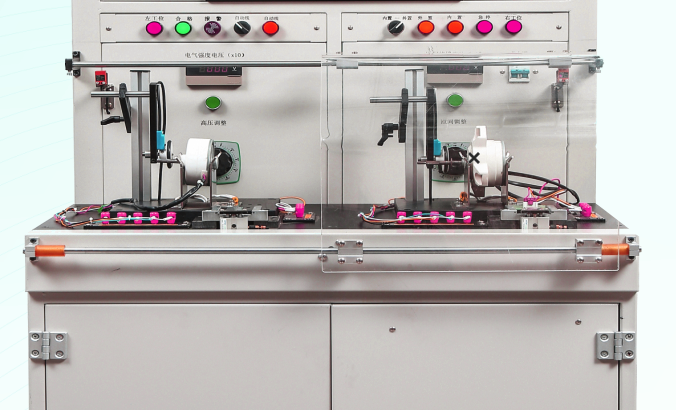What are the common mechanical failures and solutions for brushless motor motor automatic no load tester?
The common mechanical failures and solutions of brushless motor motor automatic no-load tester are as follows:
1, motor installation and connection failure
Failure phenomenon
Excessive vibration and abnormal noise of the motor in the testing process.
The motor and tester connection parts are loose and shifted, resulting in the test can not be carried out normally.
Cause analysis
Motor mounting bolts are not tightened, or the mounting surface is not flat, there are debris, so that the motor installation is not stable.
Improper installation of couplings, pulleys and other connecting parts, such as excessive deviation from concentricity and inappropriate belt tightness.
Solution
Check the motor mounting bolts, tighten them according to the specified torque, and clean the mounting surface to ensure that it is level and free of debris.
Re-adjust the installation position of coupling, pulley and other connecting parts, use professional tools to calibrate the concentricity, and adjust the belt tightness to the right state.

2、Drive system failure
Failure phenomenon
When the tester is running, the transmission parts are stuck and slipping, affecting the accuracy of motor speed and torque testing.
Transmission components have abnormal wear and tear, heat phenomenon, or even fracture, fall off and other serious problems.
Cause analysis
Belt, chain and other transmission parts are aging and stretching after long-term use, resulting in slippage.
In the gear transmission system, the gears are worn and the tooth surface is damaged, or the gear shaft is loose and the bearing is damaged.
Lack of lubrication of transmission parts, or poor quality of grease, resulting in increased friction.
Solution
Replace aged, stretched belts or chains and adjust their tension.
Check the wear of gears, replace badly worn gears, tighten gear shafts and replace damaged bearings.
Regularly lubricate the transmission parts, choose suitable grease, and lubricate according to the specified lubrication period and method.
3、Test platform and fixture failure
Failure phenomenon
The test platform is not horizontal, resulting in uneven force on the motor during the test, affecting the test results.
The fixture can not firmly clamp the motor, so that the motor displacement in the test process, or fixture damage to the motor.
Cause Analysis
The test platform is not calibrated horizontally when it is installed, or the foundation settles and the platform is deformed after long-term use.
The fixture design is unreasonable, not matching the size and shape of the motor, or the fixture parts are damaged or aged.
Solution
Use a level meter to calibrate the test platform and adjust the platform support feet to make it reach a horizontal state. Repair or replace the platform with serious deformation.
Redesign or select suitable fixtures to ensure that they are suitable for the motor. Check the fixture parts, replace the damaged and aging parts to ensure the clamping force and stability of the fixture.
4、Fan and cooling system failure
Failure phenomenon
After the tester has been running for some time, the temperature of the motor and test equipment is too high, and the fan speed is abnormal or there is a strange noise.
The cooling duct is blocked, resulting in poor cooling effect.
Cause analysis
Fan motor failure, damaged or loose fan blades, resulting in the fan not working properly.
Dust and debris accumulate in the cooling duct, blocking air flow.
Solution
Check the fan motor, repair or replace the defective motor; tighten or replace the fan blades.
Regularly clean the cooling duct, use compressed air or vacuum cleaner to remove dust and debris to ensure that the air duct is smooth.
5、Mechanical noise abnormal fault
Failure phenomenon
The tester emits abnormal mechanical noise during operation, which is obviously different from the normal operation sound.
Cause analysis
In addition to the above reasons that may lead to noise, there may also be foreign objects inside the tester to enter, friction and collision with moving parts.
Resonance problem of some mechanical parts, such as motor bracket, test platform and other parts of the inherent frequency and motor running frequency is close to trigger resonance.
Solution
Stop the machine to check the inside of the tester and clear away the foreign matter.
Reinforce and adjust the parts that may resonate to change their intrinsic frequency to avoid resonating with the motor's operating frequency.
※ If the above ways and means still can not solve the equipment failure, please contact Xinhui Electromechanical Equipment Co., Ltd. through the page chat tool to seek help.







